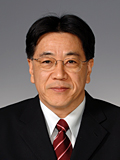
Global COE Program: Advanced Structural and Functional Materials Design
Program Completion Report

KAKESHITA Tomoyuki, Program Leader
Professor, Division of Materials and Manufacturing Science
Graduate School of Engineering
Osaka University
Five years have passed since the launch, in 2007, of this Global Center of Excellence (COE) Program, entitled "Advanced Structural and Functional Materials Design," and in March 2012 the program will come to an end. This particular program was designed to form an international hub for education and research on materials science, following on from its predecessor, a 21st Century COE Program entitled "Center of Excellence for Advanced Structural and Functional Materials Design." Together, these programs have, for the past decade, been dedicated to improving the scope and quality of education provided to students enrolled on doctoral courses in materials science at the university and to creating an optimal research environment in which talented young researchers can develop their ideas and skills as professional and pioneering researchers. The programs have also undertaken systematic reform as required, and have allowed the materials science-related divisions at Osaka University, alongside the other research organizations taking part in the programs, to establish the programs as Japan's most important centers of education and research on materials science, representing to the international community the quality of current research in this field in Japan.
Over the past five years, 78 doctoral students have been employed as Research Assistants, and they are currently playing active roles in companies, universities, and public research institutes. In particular, 11 graduates have gone on to work in public institutions, such as universities, and are already producing excellent results in their respective fields of work. Before the launch of these COE programs, Osaka University was giving little to no instruction to doctoral students, aside from that related to students' individual research. The implementation of the programs, however, prompted the introduction of core lecture programs, taken by multiple prominent researchers from diverse fields, many of whom were invited from overseas, as well as English language instruction for the purposes of presentations, discussion, and writing papers; the introduction, in other words, of an educational program designed to allow doctoral students to master the skills required to grow into an outstanding researcher or engineer. These educational programs have now been introduced as part of regular graduate educational curricula.
These programs were committed to promoting the interaction and exchange of its young researchers between and among external researchers, both inside and outside the university. Program structure was designed to allow the flexible implementation of multiple joint research projects. Overseas exchange was promoted through the formulation of exchange agreements, centered on the COE Programs, with 22 institutes and organizations around the world. The internationalization of the programs was pursued through programs of academic exchange, joint research projects, and programs of student and faculty exchange. These programs and measures were put in place not only to encourage enhanced academic exchange, but also to to allow doctoral students and young researchers the opportunity to develop vital international communications skills.
The programs have also prompted changes within Osaka University itself. Now, the three pre-existing divisions that had focused on materials science have been integrated into a single division, the Division of Materials and Manufacturing Science. Furthermore, in order to make permanent the collaborative relationships built up through these COE programs with other divisions and organizations within the Graduate School of Engineering related to fields of materials science, the university has established the Education and Research Center for
Advanced Structural and Functional Materials Design, affiliated to the Graduate School of Engineering.
21st Century COE and Global COE Programs must have been designed in order to construct a platform for graduate education, and after completion, the successes of the programs should form a legacy to be built upon and developed. The educational program and the framework for education and research in materials science and related fields developed through the two COE programs of Osaka University have been institutionalized in the form of the Education and Research Center for Advanced Structural and Functional Materials Design. The Yamamoto Memorial Hall (Building No. 2, Frontier Research Center, Graduate School of Engineering) built through private donations during the COE program period, offers the necessary organization and location for the continuance and further development of projects cultivated during the program period. Joint research courses have also been established, in collaboration with materials-related companies working in fields such as iron and steel, allowing the university to provide a platform for joint research with industry as well as involve industry in our educational programs.
We gather the talents on diverse fields, from the fundamental properties of materials to the structure control of materials, the functional enhancement of materials and manufacturing processes, as well as other areas of structural engineering (such as welding and joining), reliability assessments, and production systemsand will grow this center into one of the world's leading centers of education and research in materials science. Your continued support and guidance will be greatly appreciated.
March 2012
In accordance with the Basic Policy on the Promotion of Public Dialog on Science and Technology (determined June 19, 2010 by the Minister of State for Science and Technology Policy and Executive Members for Council for Science and Technology Policy), this Global COE Program (Advanced Structural and Functional Materials Design) will continue to operate this website after the completion of the program, in order to make the general public aware of the achievements of the program, as well as of the work and achievements of the Education and Research Center for Advanced Structural and Functional Materials Design, which will take over the work conducted by the now concluded Global COE Program.







